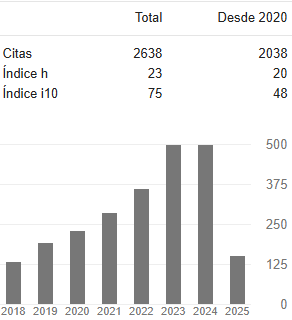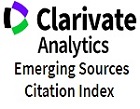Influencia de la variación de diésel en el proceso de bioventing en un suelo arenoso, en experimento en columna
DOI:
https://doi.org/10.31908/19098367.578Palabras clave:
Bioventing, diése, experimentos en columna, suelos contaminadosResumen
El presente estudio corresponde a la segunda fase del proyecto de cooperación institucional: Universidad Pontificia Bolivariana, Seccional Bucaramanga y el Instituto Colombiano de Petróleos, en buscan de una solución a la contaminación de suelos arenosos con diésel hasta concentraciones del 6% y a una profundidad máxima de 80 cm. Se contaminó un suelo artificialmente con diésel al 2%, 4% y al 6% en peso y se evaluó la técnica de Bioventing utilizando montajes en columnas. Los parámetros de seguimiento fueron: caudal de entrada, concentración de diésel, oxígeno disuelto y crecimiento bacteriano; controlados durante cuatro meses. Los resultados mostraron que la técnica de Bioventing es efectiva para suelos arenosos, con bajos contenidos de materia orgánica, caudales de infiltración bajos, pH entre 6 – 8, temperatura de operación de 22°C y concentraciones de oxígeno disuelto superiores a 0,5 mg/L, presentando porcentajes de remoción de diésel superiores al 50% en suelos contaminados a una concentración de diésel del 2% en peso.
Descargas
Referencias
B. Thapa, A.K.C Kumar and Ghimire A, A review on bioremediation of petroleum hydrocarbon contaminants in soil, Kathmandu university journal of science, engineering and technology, 8(1). 164-170, 2012.
C. Bona, I. Rezende, G. Santos and L. Souza, Effect of soil contaminated by diesel oil on the germination of seeds and the growth of Schinus terebinthifoilus, Brazilian Archives of Biology and Technology, 54(6). 1379-1387, 2011.
L. Reynoso-Cuevas, M.E. Gallegos Martinez, F. Cruz Sosa and M. Gutiérrez Rojas, In vitro evaluation of germination and growth of five plant species on medium supplemented with hydrocarbons associated with contaminated soils, Bioresource Technology, 99(14). 6379-6385, 2008.
L. Nogueira, R. Inckot, G. Santos, L. Souza and C. Bona, Phytotoxicity of petroleum contaminated soil and bioremediated soil on Allphylus edulis, Rodriguiesia, 62(3). 459-466, 2011.
R.S. Ramadha, R.N. Jabbar and N. Abadulatif, Isolation, identification and assessment of the ability of local Streptomyces isolate from Iraq to utilize crude oil and diesel fuel, Al Gafarietal Scientific Research and Impact, 2(1). 9-28, 2013.
E.H. Lee, Y.S. Kang and K.S Cho, Bioremediation of diesel contaminated soils by natural attenuation, Biostimulation and Bioaugmentation employing Rhodococcus sp. EH831, Korean Journal Microbiology Biotechnology, 39(1). 86-92, 2011.
W. Graj, P. Lisiecki, A. Szulc, L. Chrzanowski and K.J. Wojtera, Bioaugmentation with petroleum degrading consortia has a selective growth promoting impact on crop plants germinated in diesel oil contaminated soil. Water Air, Soil Pollution, 224. 1676, 2013.
S. Anjana, K. Poonam and B.R. Meenal BR, Biodegradation of Diesel Hydrocarbon in Soil by Bioaugmentation of Pseudomonas aeruginosa: A Laboratory Scale Study. International Journal of Environmental Bioremediation & Biodegradation, Vol. 2, No. 4, 202-212, 2014.
M.C. Marley, D.J. Hazebrouck and M.T. Walsh MT, The application of in situ air sparging as an innovative soils and ground-water remediation technology. Ground Water Monit Remediat 12:137–145, 1992.
K.R. Reddy, S. Kosgi and J.N Zhou, A Review of in-situ air sparging for the remediation of voc-contaminated saturated soils and groundwater. Hazard Waste Hazard Mater 12:97–118, 1995.
D.H. Bass, N.A. Hastings and R.A Brown RA, Performance of air sparging systems: a review of case studies. J Hazard Mater 72:101– 119, 2000.
B.L. Hall, T.E. Lachmar and R.R. Dupont, Field monitoring and performance evaluation of an in situ air sparging system at a gasolinecontaminated site. J Hazard Mater 74:165–186, 2000.
G. Heron, J.S. Gierke, B. Faulkner, S. Mravik, L. Wood and C.G Enfield, Pulsed air sparging in aquifers contaminated with dense nonaqueous phase liquids. Ground Water Monit Remediat 22:73–82, 2002.
X.M. Yang, D. Beckmann, S. Fiorenza and C. Niedermeier, Field study of pulsed air sparging for remediation of petroleum hydrocarbon contaminated soil and groundwater. Environ Sci Technol 39:7279– 7286, 2005.
M.H. Huesemann and M.J. Truex, The role of oxygen diffusion in passive bioremediation of petroleum contaminated soils. J. Hazard. Mater. 51, 93–113, 1996.
D. Brinkmann, J. Röhrs and K. Schügerl, K, Bioremediation of diesel fuel contaminated soil in a rotating bioreactor Part I: Influence of oxygen saturation. Chem. Eng. Technol. 21, 168–172, 1998.
J. Troquet, C. Larroche and C.G. Dussap, Evidence for the occurrence of an oxygen limitation during soil bioremediation by solid-state fermentation. Biochem. Eng. J. 13, 103–112, 2003.
U.S. EPA. Manual: Bioventing Principles and Practice. Volume II: Bioventing Design. EPA/540/R-95/534a. 1995.
S.C. Choi, K.K. Kwon, J.H. Sohn and S.J. Kim, Evaluation of fertilizer additions to stimulate oil biodegradation in sand seashore mescocosms. J. Microbiol. Biotechnol. 12:431-436, 2002.
S. Kim, D.H. Choi, D.S. Sim and Y. Oh, Evaluation of bioremediation effectiveness on crude oil-contaminated sand. Chemosph. 59: 845- 852, 2005.
J.J. Cooney, The fate of petroleum pollutants in freshwater ecosystems. K 03099 Pollution; J 02905 Water; P 2000 Freshwater Pollut. 1984.
M. Alexander, Biodegradation and Bioremediation 2nd ed. Academic Press, London, 1999.
R. Bartha R, Microbial ecology: fundamentals and applications. Addisson_Wesley Publ., Reading, Mass, 1986a.
R.P.J. Swanell, K Lee and M. McDonagh, Field evaluation of marine oil spill bioremediation. Microb. Rev. (June): 342-365, 1996.
S. H. Ferguson, P. D. Franzmann, I. Snape, A.T. Revill, M.G. Trefry and L.R. Zappia, Effects of temperature on mineralisation of petroleum in contaminated Antartic terrestrial sediments. Chemosphere 52, 975– 987, 2003.
S. Schiewer and T. Niemeyer, Soil heating and optimized nutrient addition for accelerating bioremediation in cold climates. Polar Record, 42, 23–31, 2006.
J.S. Poland, J.A. Page, K. Paudyn, A. Rutter and Rowe, R. K, Remediation of hydrocarbon contaminated soils in the Canadian Arctic with landfarms. In Biggar, K., Guidard, S., Mullick, A., and Nahir,M. (eds.), Proceedings of the Assessment and Remediation of Contaminated Sites in Arctic and Cold Climates workshop. pp. 209– 215, Edmonton, AB, 6–8 May, 2007.
J.S. Heath, K. Koblis, S.L. Sager and Day, C, Hydrocarbon Contaminated Soils. Volumen III. Boca Raton: Lewis Publishers, 1993.
N. Das and P. Chandran, Microbial degradation of petroleum hydrocarbon contaminants: An Overview, 2010.
M. Bouchez, D. Blanchet and J.P Vandecasteele, The microbial fate of polycyclic aromatic hydrocarbons: carbon and oxygen balances for bacterial degradation of model compounds, Applied. Microbiology and Biotechnology, vol 45(4), 556–561. 1996.
H. Mulder, AM Breure, J.G.V. Andel, J.T.C Grotenhuis and W.H Rulkens WH, Influence of thermodynamic conditions on naphthalene dissolution and subsequent biodegradation. Biotechnol Bioeng.;57:145–154, 1998.
P.L. Stelmack PL, M.R. Gray and M.A. Pickard, Bacterial adhesion to soil contaminants in the presence of surfactant. Appl Environ Microbiol. 65:163–168, 1999.
M. Bouchez, D. Blanchet, V. Bardin and J.P. Vandecasteele, Evidence for interfacial uptake in hexadecane degradation by Rhodococcus equi: the importance of cell flocculation. Microbiology, vol 147(9). 2537-43, 2001.
P. Goswami, H.D. and Singh HD, Different modes of hydrocarbon uptake by two Pseudomonas species. Biotechnol Bioeng.;37:1–11, 1991.
G.S. Shreve, S. Inguva and S. Gunnam S, Rhamnolipid biosurfactant enhancement of hexadecane biodegradation by Pseudomonas aeruginosa. Mol Mar Biol Biotechnol.;4:331–337, 1995.
J. Ortega-Calvo and P.M. Gschwend, Influence of Low Oxygen Tensions and Sorption to sediment Black Carbon on Biodegradation of Pyrene. Applied & Environmental Microbiology, 76 (13), 4430-4437, 2010.
P. Franzmann, W. Robertson, L. Zappia and G. Davis, G, The role of microbial populations in the containment of aromatic hydrocarbons in the subsurface. Biodégradation. Países Bajos. 13:65-78, 2002.
M. Aitken, M, Mechanisms of organic pollutant transformation and degradation by microorganisms. En : Bioremediation : Principles and Practice. Volumen I : Fundamentals and Applications. Editado por Sikdar, S. e Irvine, R.. Technomic Publication. Pennsylvania, Estados Unidos. p. 333-383, 1998.
P. Werner, P. Börke, P and N. Hüsers, Leitfaden Natürliche Schadstoffminderung bei Teerölaltlasten, im BMBF Förderschwerpunkt KORA. Schriftenreihe des Institutes für Abfallwirtschaft und Altlasten, TU Dresden, Band 58 ISBN 978-3-934253-50-6, 2008.
D. Wabbels and G. Teutsch, Leitfaden Natürliche Schadstoffminderungsprozesse bei mineralölkontaminierten Standorten. KORA Themenverbund 1: Raffinerien, Tanklager, Kraftstoffe/Mineralöl, MTBE. ZAG Universität Tübingen, ISBN 978- 3-89746-093-9, 2008.
D. Gibson, and R. Parales, Rebecca, Aromatic hydrocarbon dioxygenases in environmental biotechnology. Current Opinion in Biotechnology 2000, 11:236–243. 2000.
L. Plata, A. Muskus y C. Santoyo, Evaluación de la influencia de una cepa bacteriana en la biorremediación de un suelo arenoso contaminado con diésel, a escala de laboratorio. Universidad Pontificia Bolivariana, Seccional Bucaramanga. Facultad de Ingeniería Ambiental, 2012.
DIN V 19736 Ableitung von Konzentrationen organischer Stoffe im Bodenwasser. Normenausschuß Wasserwesen (NAW).- DIN: Deutsches Institut für Normung e.V. (Ref.Nr. DIN V 19736:1998-10), 1998.
L. Fernánde, Manual de técnicas de análisis de suelos aplicadas a la remediación de sitios contaminados. Instituto Mexicano del Petróleo Secretaría de Medio Ambiente y Recursos Naturales Instituto Nacional de Ecología, 2006.
M. Maroto M y Rogel J, Aplicación de Sistemas de Biorremedación de Suelos y Aguas Contaminadas por Hidrocarburos, 2000. Disponible online:http://www.igme.es/internet/ewb_aguas/igme/publica/con_ recu_acuiferos/028.pdf
V. Andreoni, L. Cavalca, M.A. Rao, G. Nocerino, S. Bernasconi and E. Dell’Amico, Bacterial Communities and Enzyme Activities of PAHs Polluted soils, Chemosphere; Vol 57: 401-412, 2004.
H. Malgorzata and M. Malgorzata, The influence of diesel fuel and biodiesel on soil microbial biomass. Departmen of Microbiology and environmental biotechnology, Slowackiego 17, 71-434, Poland. Polish Journal of environmental studies. Vol.20, NO. 2 (2011), 497-501, 2010.
A. Lapinskiené and P. Martinlus, Research on anaerobic biodegradation of fats, biodiesel fuel and diesel fuel in soil medium. Environmental research, engineering and management, Vol. 39. No. 1, 30.37, 2007.
Descargas
Publicado
Número
Sección
Licencia
Derechos de autor 2019 Entre Ciencia e Ingeniería

Esta obra está bajo una licencia internacional Creative Commons Atribución-NoComercial 4.0.



















